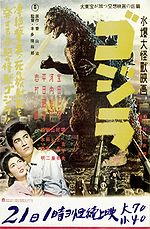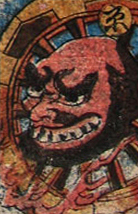Monster
This articleneeds additional citations forverification.(October 2016) |

Amonsteris a type of fictional creature found inhorror,fantasy,science fiction,folklore,mythologyandreligion.Monsters are very often depicted as dangerous andaggressive,with a strange or grotesque appearance that causes terror andfear,often in humans. Monsters usually resemblebizarre,deformed, otherworldly and/or mutatedanimalsor entirely unique creatures of varyingsizes,but may also take ahumanform, such asmutants,ghosts,spirits,zombies,orcannibals,among other things. They may or may not have supernatural powers, but are usually capable of killing or causing some form of destruction, threatening the social ormoralorder of the human world in the process.
Animal monsters are outside the moral order, but sometimes have their origin in some human violation of the moral law (e.g. in the Greekmyth,Minosdoes not sacrifice toPoseidonthe white bull which the god sent him, so as punishment Poseidon makes Minos' wife,Pasiphaë,fall in love with the bull. She copulates with the beast, and gives birth to the man with a bull's head,the Minotaur). Human monsters are those who by birth were never fully human (Medusaand herGorgonsisters) or who through some supernatural or unnatural act lost their humanity (werewolves,Frankenstein's monster), and so who can no longer, or who never could, follow the moral law of human society.
Monsters may also be depicted as misunderstood and friendly creatures who frighten individuals away without wanting to, or may be so large, strong and clumsy that they cause unintentional damage or death. Some monsters in fiction are depicted as mischievous and boisterous but not necessarily threatening (such as a slygoblin), while others may be docile but prone to becoming angry or hungry, thus needing to be tamed and taught to resist savage urges, or killed if they cannot be handled or controlled successfully.
Monsters pre-datewritten history,and the academic study of the particular cultural notions expressed in a society's ideas of monsters is known asmonstrophy.[1]Monsters have appeared in literature and in feature-length films. Well-known monsters in fiction includeCount Dracula,Frankenstein's monster,werewolves,vampires,demons,mummies,andzombies.
Etymology[edit]

Monsterderives from theLatinmonstrum,itself derived ultimately from the verbmoneo( "to remind, warn, instruct, or foretell" ), and denotes anything "strange or singular, contrary to the usual course of nature, by which the gods give notice of evil," "a strange, unnatural, hideous person, animal, or thing," or any "monstrous or unusual thing, circumstance, or adventure."[2]
Cultural heritage[edit]
In the words of Tina Marie Boyer, assistant professor of medieval German literature atWake Forest University,"monsters do not emerge out of a cultural void; they have a literary and cultural heritage".[3]
In the religious context of ancient Greeks and Romans, monsters were seen as signs of "divine displeasure", and it was thought that birth defects were especially ominous, being "an unnatural event" or "a malfunctioning of nature".[4]
Monsters are not necessarily abominations however. The Roman historianSuetonius,for instance, describes a snake's absence of legs or a bird's ability to fly as monstrous, as both are "against nature".[5]Nonetheless, the negative connotations of the word quickly established themselves, and by the playwright and philosopherSeneca's time, the word had extended into its philosophical meaning, "a visual and horrific revelation of the truth".[6]
In spite of this, mythological monsters such as theHydraandMedusaare not natural beings, but divine entities. This seems to be a holdover fromProto-Indo-European religionand other belief systems, in which the divisions between "spirit," "monster," and "god" were less evident.
Monsters in fiction[edit]
Prose fiction[edit]
The history of monsters in fiction is long. For instance,Grendelin the epic poemBeowulfis an archetypal monster: deformed, brutal, and with enormous strength, he raids a human settlement nightly to slay and feed on his victims. The modern literary monster has its roots in examples such as the monster inMary Shelley'sFrankensteinand the vampire inBram Stoker'sDracula.
Monsters are a staple offantasy fiction,horror fiction,andscience fiction(where the monsters are oftenextraterrestrialinnature). There also existsmonster erotica,a subgenre oferotic fictionthat involves monsters.
Film[edit]
Pre–World War II monster films[edit]

During the age ofsilent films,monsters tended to be human-sized, e.g.Frankenstein's monster,theGolem,werewolvesandvampires.The filmSiegfriedfeatured adragonthat consisted ofstop-motion animatedmodels, as inRKO'sKing Kong,the first giantmonster filmof the sound era.
Universal Studiosspecialized in monsters, withBela Lugosi's reprisal of his stage role,Dracula,andBoris KarloffplayingFrankenstein's monster.The studio also made several lesser films, such asMan-Made Monster,starringLon Chaney Jr.as a carnival side-show worker who is turned into an electrically charged killer, able to dispatch victims merely by touching them, causing death by electrocution.
There was also a variant of Dr. Frankenstein, the mad surgeon Dr. Gogol (played byPeter Lorre), who transplanted hands that were reanimated with malevolent temperaments, in the filmMad Love.
Werewolveswere introduced in films during this period, and similar creatures were presented inCat People.Mummieswere cinematically depicted as fearsome monsters as well. As for giant creatures, the cliffhanger of the first episode of the 1936Flash Gordonserialdid not use a costumed actor, instead using real-lifelizardsto depict a pair of battling dragons via use of camera perspective. However, the cliffhanger of the ninth episode of the same serial had a man in a rubber suit play the Fire Dragon, which picks up a doll representing Flash in its claws. The cinematic monster cycle eventually wore thin, having a comedic turn inAbbott and Costello Meet Frankenstein(1948).
Post–World War II monster films[edit]

In thepost–World War IIera, however, giant monsters returned to the screen with a vigor that has been causally linked to the development ofnuclear weapons.One early example occurred in the American filmThe Beast from 20,000 Fathoms,which was about adinosaurthat attacked a lighthouse. Subsequently, there wereJapanesefilm depictions, (Godzilla,Gamera), British depictions (Gorgo), and evenDanishdepictions (Reptilicus), of giant monsters attacking cities. A recent depiction of a giant monster is depicted inJ. J. Abrams'sCloverfield,which was released in theaters 18 January 2008. The intriguing proximity of otherplanetsbrought the notion of extraterrestrial monsters to the big screen, some of which were huge in size (such asKing GhidorahandGigan), while others were of a more human scale. During this period, thefish-man monsterGill-manwas developed in the film seriesCreature from the Black Lagoon.

Britain'sHammer Film Productionsbroughtcolorto the monster movies in the late 1950s. Around this time, the earlier Universal films were usually shown on American television by independent stations (rather than network stations) by using announcers with strange personas, who gained legions of young fans. Although they have since changed considerably, movie monsters did not entirely disappear from the big screen as they did in the late 1940s.
Occasionally, monsters are depicted as friendly or misunderstood creatures. King Kong and Frankenstein's monster are two examples of misunderstood creatures. Frankenstein's monster is frequently depicted in this manner, in films such asMonster SquadandVan Helsing.The Hulkis an example of the "Monster as Hero" archetype. The theme of the "Friendly Monster" is pervasive in pop-culture.Chewbacca,Elmo,andShrekare notable examples of friendly "monsters". The monster characters ofPixar'sMonsters, Inc.franchise scare (and later entertain) children in order to createenergyfor running machinery in their home world, while the furry monsters ofThe MuppetsandSesame Streetlive in harmony with animals and humans alike. Japanese culture also commonly features monsters which are benevolent or likable, with the most famous examples being thePokémonfranchise and the pioneering animeMy Neighbor Totoro.The book series/webisodes/toy line ofMonster Highis another example.
Games[edit]
Monsters are commonly encountered in fantasy or role-playing games, as well as video games, as enemies for players to fight against. They may includealiens,legendary creatures,extra-dimensional entities ormutatedversions of regular animals.
Especially in role-playing games, "monster" is a catch-all term for hostile characters that are fought by the player.Sentientfictional racesare usually not referred to as monsters. At other times, the term can carry a neutral connotation, such as in thePokémonfranchise, where it is used to refer to cute fictional creatures that resemble real-world animals. Characters in games may refer to all of such creatures as "monsters". Another role playing game that has many different fantasy creatures (monsters and dragons alike), isDungeons & Dragons.
In some other games, such asUndertaleandDeltarune,"Monsters" (which are usually NPCs) refer to strange beings that are eitherundead,robots,humanoidsor mythical creatures that share similarities with human beings.
See also[edit]
Monsters in legend and fiction[edit]
This section'sfactual accuracy isdisputed.(November 2023) |
- Abaia
- Almas
- Angel
- Bakunawa
- Banshee
- Basilisk
- Beast of Gévaudan
- Behemoth
- Bigfoot
- Bishop-fish
- Bogeyman
- Bunyip
- Centaur
- Cerberus
- Changeling
- Charybdis
- Chimera
- Cryptozoology
- Cyclopes
- Cetus
- Cockatrice
- Demon
- Draugr
- Dragon
- Dr. Jekyll and Mr. Hyde
- Dwarf
- Elf
- Extraterrestrial life
- Fairy
- Fearsome Critters
- Fouke Monster
- Frankenstein
- Gargoyle
- Gashadokuro
- Gill-man
- Goblin
- Ghoul
- Ghost
- Goblin
- Gorgon
- Gremlin
- Griffin
- Grim Reaper
- Gnome
- Headless Horseman
- Horned Serpent
- Imp
- Invisible Man
- Hydra
- Jersey Devil
- Jiangshi
- Jinn
- Kaiju
- Kelpie
- Kraken
- Krampus
- Lake monster
- Loch Ness monster
- Legendary creature
- Leviathan
- Manticore
- Mermaid
- Midgard Serpent
- Minokawa
- Minotaur
- Mummy
- Mythological hybrid
- Ogre
- Oni
- Orc
- Pegasus
- Pixie
- Satyr
- Scylla
- Sea monster
- Skeleton
- Swamp monster
- Tarasque
- Troll
- Tikbalang
- Undead
- Vampire
- Warg
- Wendigo
- Werewolf
- Yaksha
- Yaoguai
- Yeti
- Yōkai
- Yara-ma-yha-who
- Zombie
Related concepts[edit]
References[edit]
Notes[edit]
- ^Each card features a monster fromJapanese mythologyand a character from thehiraganasyllabary.
Citations[edit]
- ^ "Call for Papers for Preternature 2.2".Dr Leo Ruickbie. 28 November 2011.Retrieved30 December2017.
- ^The Rev. J.E. Riddle,A Complete English-Latin and Latin-English Dictionary,London: Longmans, Green, and Co., 1870, s.v.monstrum,Latin-English part, p. 399.
- ^ Boyer, Tina Marie (2013). "The Anatomy of a Monster: The Case of Slender Man".Preternature: Critical and Historical Studies on the Preternatural.2(2).
- ^Beagon (2002),p. 127.
- ^Wardle (2006),p. 330.
- ^Staley (2010),pp. 80, 96, 109, 113 et passim.
Bibliography[edit]
- Asma, Stephen (2009).On Monsters: An Unnatural History of Our Worst Fears.Oxford University Press.ISBN978-0195336160.
- Beagon, Mary (2002). "Beyond Comparison: M. Sergius, Fortunae victor". In Clark, Gillian; Rajak, Tessa (eds.).Philosophy and Power in the Graeco-Roman World: Essays in Honour of Miriam Griffin.Oxford University Press.ISBN978-0-19-829990-5.
- Staley, Gregory A. (2010).Seneca and the Idea of Tragedy.Oxford University Press.ISBN978-0-19-538743-8.
- Wardle, David (2006).Cicero on Divination, Book 1.Oxford University Press.
- Weinstock, Jeffrey Andrew, ed. (2020).The Monster Theory Reader.University of Minnesota Press. 2020.
External links[edit]
 Media related toMonstersat Wikimedia Commons
Media related toMonstersat Wikimedia Commons
